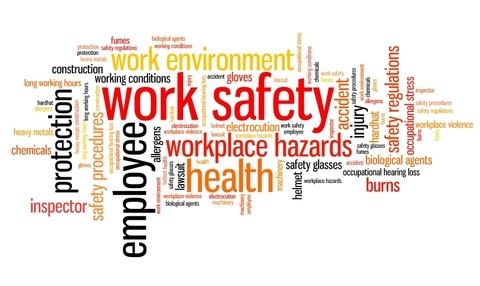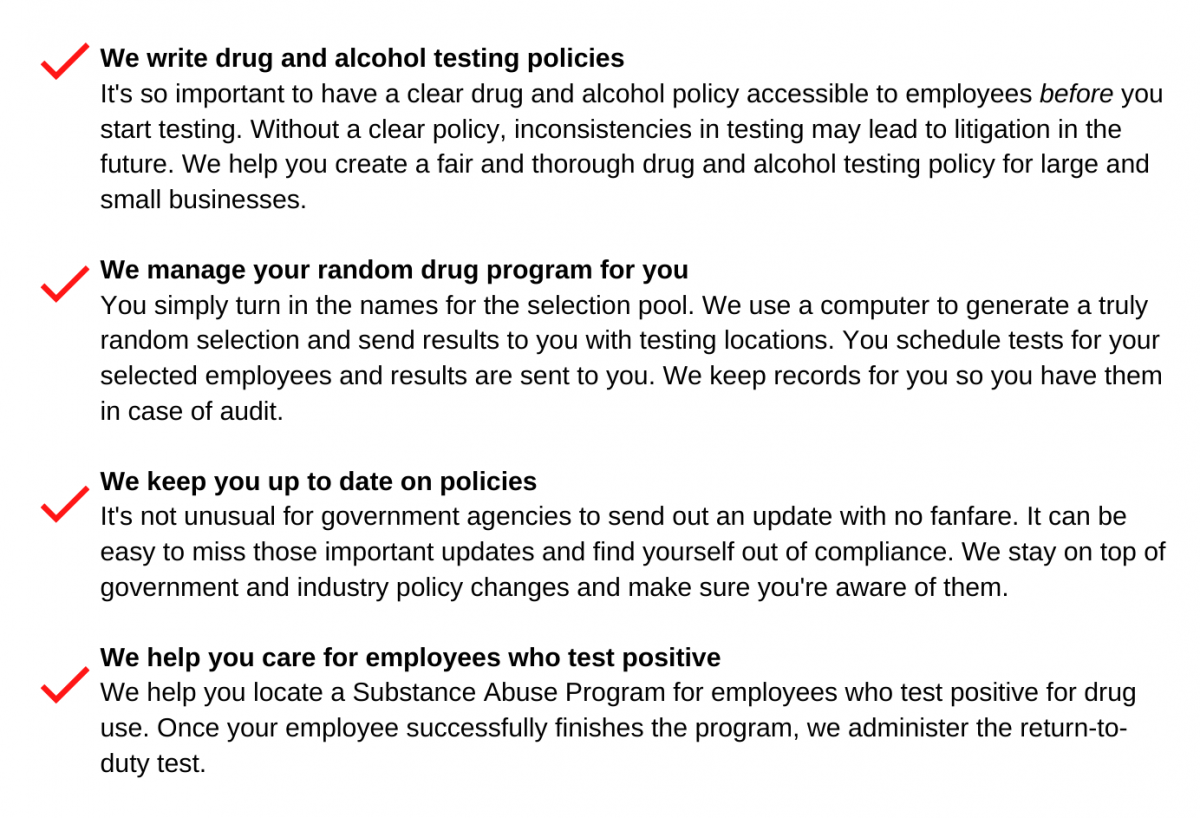What is the Purpose of Random Drug Testing?

Random drug testing is one of the easiest ways to improve workplace safety, not because you may catch drug users, although you may. That’s not the point. Random Drug Testing deters drug use and ensures a sober workforce without singling out specific employees.
Detecting drug use among employees is nearly impossible. Once the signs are obvious, it’s often too late because obvious signs generally include accidents or injury. Employees using drugs are more likely to injure him/herself or others, increasing your accident/injury and fatality rates.
Why implement Random Drug Testing?
Drug users tend to take more sick days and their turnover rate is usually higher. If employees are high, productivity is usually low. All of this costs your company thousands.
Without a random drug testing policy, you can’t be sure your employees are safe. You reduce costs and liability significantly when you implement random drug testing.
To see more statistics on how drug use affects your business, check out our article, “Do I Really Need a Drug & Alcohol Testing Policy?”
How does Random Drug Testing Work?
Random drug testing is unannounced and unexpected. Employees don’t know they’re testing until it’s time to test. An employer, or Third Party Administrator (TPA) like Lobdock Impairment Detection, uses a random selection process to select a percentage of employees in the drug testing program.
The process is usually computer-generated to ensure no bias in selection. All employees have an equal chance at selection during each cycle, even if they were recently chosen.
Note: it is not acceptable to randomly select participants by choosing numbers from a hat, rolling dice, throwing darts, picking cards, or selecting ping pong balls (yeah, we know…we had to say it).
The federal government requires random drug testing for all safety-sensitive workers. Your drug policy should state the rate of random selection (example: 50% of employees) and how often (50% annually, spread out equally throughout the year).
Be sure you understand what your regulating agency requires. Employers not regulated by the federal government can set their own random drug testing rate and schedule.
All employees are put into the random pool for every random cycle. Let’s say you have 100 employees and your random drug testing rate is 50% annually. That means every quarter, all 100 employees are put in the pool and you’ll select 12 names for 2 quarters and 13 names for 2 quarters. At the end of the year, you would have pulled 50 names.
Is it possible that some people may be pulled twice or more? Sure. That’s the “luck of the draw.” Make sure you document your random drug testing process, how you selected names, and who was selected each time to avoid coming under scrutiny for bias. Hiring a TPA to manage your random drug testing program relieves you of some of that scrutiny.
How Do I Implement Random Drug Testing?
Best practices for random drug testing:
True random selection requires the use of a statistically random generator, often computer-based.
Limit the time between notification and testing. Make sure you know your chosen drug testing clinic hours and policies. The Department of Transportation (DOT) allows for 30 min. plus reasonable travel time. Make sure arrival time is clearly stated on their drug test form. If an employee doesn’t make it to the drug testing facility in time, it may be considered a refusal to test. Ultimately, the Designated Employer Representative (DER) decides if a delay constitutes a refusal to test. The collection site should call the DER to notify them of a delay. The DER, then determines if the delay was justified or not.
Stay up to date on state and federal drug testing regulations. Failure to remain compliant often results in heavy fines for your company.
Know what your industry requires regarding drug testing. You may be regulated by your industry as well as the federal or state government. For example, what is the time frame you have to work within to complete random drug testing? FMCSA allows testing anytime within the quarter. Other regulators only allow a few days for employers to send workers for random drug testing.
Maintain complete documentation for each employee throughout the entire testing process. Include how many were pulled, selected employees’ names, date and time of notification, reasons why a selected employee was not tested, date and time of collection and any other necessary information. This proves invaluable in case of an audit or litigation.
How Should I Notify Employees?
Notification should be discreet and according to your company policy. You, the employer, have a responsibility to ensure an enforce confidentiality and maintain the element of surprise.
It’s important to limit the number of people with access to your random drug pulls. Carefully consider who can see results. Best practice calls for one person to have access to notices to order drug tests and another has access to results.
What if a selected employee is not available for testing?
Every employer must state in their drug policy what to do if an employee is pulled for a random drug test and isn’t available. We saw a lot of this during the Covid pandemic. If an employee is out for an extended period of time, best practice includes detailed documentation as to why an employee is unavailable. You can choose to make another selection to fulfill your numbers or make an extra selection during the next cycle. You are not allowed to move that employee to the next round. If an employee is simply gone the day of selection, schedule the test for his next shift. Make sure you understand the regulations of the agencies that govern you.
There are very few exceptions for missing random drug testing, including fasting. Check out our case study.
What if an employee tests positive for drugs?
It depends on your drug policy. Address this before it’s a problem. Whether you’re regulated by the federal government or not, you should provide your employee with Substance Abuse Program (SAP) information.
You are perfectly within your rights to allow your employee to return to work. DOT requires that you provide SAP information and the employee must have a negative return-to-duty test before they can return. Even if you choose to terminate on the spot, you should still offer SAP information.
What if I’m regulated by the Department of Transportation (DOT)?
The Department of Transportation (DOT) Random Drug Test Requirements include:
- Minimum drug testing rate of 50%, alcohol testing rate of 10% annually.
Example: If you had 100 employees, you would be required to randomly test at least 50 for drugs and at least 10 for alcohol. The total annual number is divided by four so testing is done every quarter.
- Safety-sensitive workers are required to participate in DOT random drug testing, separate from your non-DOT testing program.
- If you are regulated by several different agencies within the DOT, you may put your employees in the same random pool.
- If you have an employee performing duties subject to more than one DOT agency’s regulations, that employee follows random testing for the agency that regulates the job he performs more than 50% of the time.
DOT suggests quarterly random selection and drug testing. Some may choose to select and test more frequently. Your annual drug testing rate requirement should be spread out equally throughout the year.
Larger companies may have enough random pulls to allow for testing more frequently than quarterly. Smaller companies may not. When you spread testing equally throughout the year, it needs to be done in a non-predictable pattern.
What if you’re a small or one-person company?
Obviously, if you’re small or a one-man-shop, you may not need to establish a random drug testing policy. However, if your work is safety-sensitive, the federal government requires random drug testing.
How do you randomly select yourself? You can (or may be required to) join a consortium. This is a pool of owner/operators and small companies joined together with other owner/operators and small companies and managed by a Third Party Administrator (TPA). The TPA puts all the names in the pool and randomly selects according to the rate requirements set by the regulating agency.
As you see (and probably already know) managing your random drug program takes a lot of work. It may be more than your human resources department can handle without taking attention away from other important job duties.
This is overwhelming. Can I get help?
Yes! A TPA that manages your random drug testing program takes the work out of workplace safety.
Lobdock Impairment Detection offers more than random drug testing management.
Advantages of hiring Lobdock:

Although running a random drug testing program may seem intimidating, it’s necessary for your success. The success of your random program depends on the element of surprise. Employees are less likely to use drugs if they know they could be called to test any day. Fewer drug incidents lead to better profitability and success.
Imagine how much more time and attention you would have for other things if you chose Lobdock Impairment Detection to manage your random drug testing program.
Contact Lobdock Impairment Detection for answers to your drug testing questions.
If you suspect drug or alcohol use in your workplace, it’s important to have a plan.
Sign up for our monthly e-newsletter and get a FREE Reasonable Suspicion Confrontation Planner
Follow us on social media for updates, tips, and a little bit of fun!
